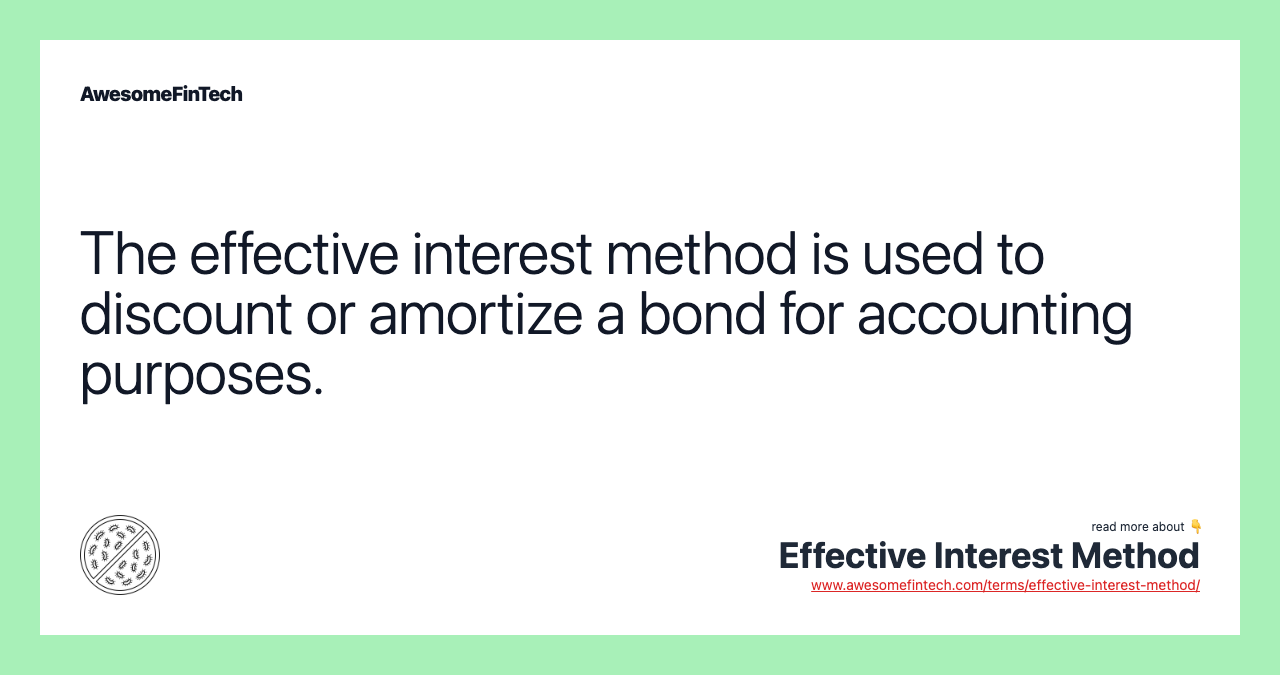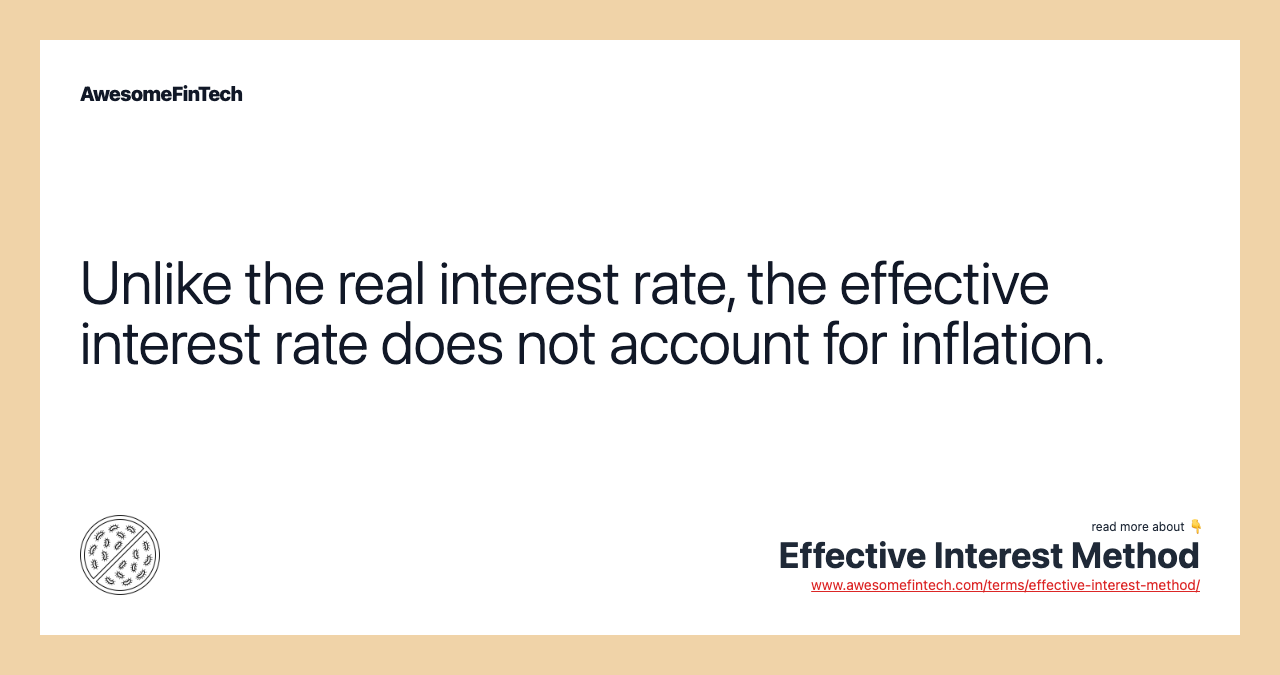Effective Interest Method
The effective interest method is an accounting standard used to amortize, or discount a bond. This method accounts for accretion of a bond discount as the balance is moved into interest income or to amortize a bond premium into an interest expense. Unlike the real interest rate, the effective interest rate does not account for inflation. The effective interest method comes into play when bonds are purchased at a discount or premium. The effective interest rate uses the book value, or the carrying amount of the bond, to calculate interest income, and the difference between interest income and the bond’s interest payment is the amount of the accretion or amortization posted each year. If a bond is purchased at less than par, the amount below the par value is the bond discount, and since the bond returns the par amount to the purchaser at maturity, the discount is additional bond income to the buyer. The bond’s interest income is calculated as the carrying amount multiplied by the at the market interest rate, which is the total return earned on the bond given the discount paid and the interest earned.

What Is the Effective Interest Method?
The effective interest method is an accounting standard used to amortize, or discount a bond. This method is used for bonds sold at a discount, where the amount of the bond discount is amortized to interest expense over the bond's life.
The effective interest rate uses the book value, or the carrying amount of the bond, to calculate interest income, and the difference between interest income and the bond’s interest payment is the amount of the accretion or amortization posted each year.



Understanding Effective Interest Method
The effective interest method comes into play when bonds are purchased at a discount or premium. Bonds are normally issued at par or face value of $1,000 and sold in multiples of $1,000. If a bond is purchased at less than par, the amount below the par value is the bond discount, and since the bond returns the par amount to the purchaser at maturity, the discount is additional bond income to the buyer. In a similar way, a bond purchased at a price above par includes a bond premium, and the premium is an additional expense to the bond buyer because the buyer only receives the par amount at maturity.
Effective Interest Method and Accretion
Assume an investor buys bonds with a $500,000 par value and a coupon rate of 6%. The bonds are purchased for $377,107, which includes a bond discount from par of $122,893. The bond’s interest income is calculated as the carrying amount multiplied by the at the market interest rate, which is the total return earned on the bond given the discount paid and the interest earned. In this case, assume the market interest rate is 10%, which is multiplied by the $377,107 carrying amount to calculate $37,710 in interest income.
The bond pays annual interest of 6% on a $500,000 par amount, or $30,000, and the difference between the interest paid and interest income, or $7,710, is the amount of the bond discount accretion for year one. The bond accretion for the year is moved into bond income, and the accretion amount is also added to the carrying amount, making the new carrying amount of $384,817, which is used to calculate bond accretion for year two. At the end of the 10-year life of the bond, the carrying amount is adjusted up to the $500,000 par amount.
Factoring in Bond Amortization
A bond purchased at a premium generates a larger cost of debt for the bond buyer, because the premium paid is amortized into bond expense. Assume, in this case, a 4.5%, $100,000 par value bond is purchased for $104,100, which includes a $4,100 premium. The annual interest payment for the bond is $4,500, but the interest income earned in year one is less than $4,500 because the bond was purchased at a market rate of only 4%. The actual interest income is 4% multiplied by the $104,100 carrying amount, or $4,164, and the premium amortization for year one is $4,500 less $4,164, which equals $336. The amortization of $336 is posted to bond expense, and the amount also reduces the carrying amount of the bond.
Related terms:
Accreted Value
Accreted value is a bond’s current value on a balance sheet including the interest accrued even though that is not paid until the bond matures. read more
Accretion of Discount
Accretion of discount is the increase in the value of a discounted instrument as time passes and the maturity date looms closer. read more
Accretion
Accretion is business growth from internal expansion or through mergers and acquisitions. read more
Amortizable Bond Premium
A tax term, the amortizable bond premium refers to the excess price (the premium) paid for a bond, over and above its face value. read more
Amortization : Formula & Calculation
Amortization is an accounting technique used to periodically lower the book value of a loan or intangible asset over a set period of time. read more
At-the-Market
An at-the-market order buys or sells a stock or futures contract at the prevailing market bid or ask price at the time it gets processed. read more
Bank Discount Basis
Bank discount basis is a convention used when quoting prices for fixed income securities sold at a discount, such as U.S. Treasury bills. read more
Bond : Understanding What a Bond Is
A bond is a fixed income investment in which an investor loans money to an entity (corporate or governmental) that borrows the funds for a defined period of time at a fixed interest rate. read more
Book Value : Formula & Calculation
An asset's book value is equal to its carrying value on the balance sheet, and companies calculate it by netting the asset against its accumulated depreciation. read more
Cost of Debt & How to Calculate
Cost of debt is the effective rate that a company pays on its current debt as part of its capital structure. read more